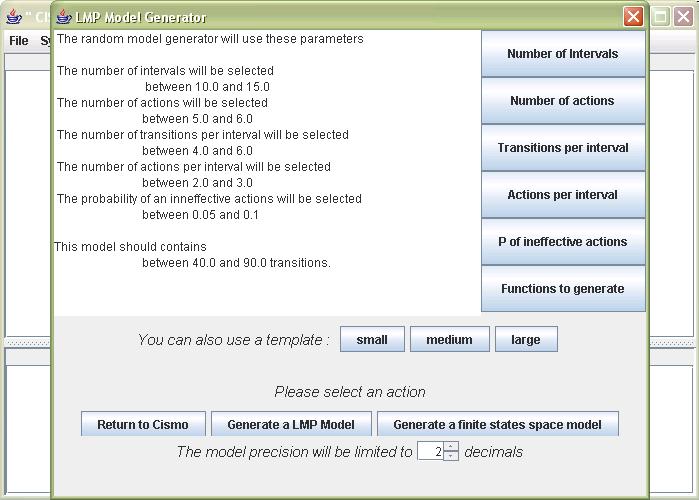
Random model generator

The generator can be used to generate a random LMP system as well as a standard finite state space model. All the parameters provided are in the form of intervals, so you will obtain models that vary both in size and construction. If you want to obtain precise parameters, provide the same number for the upper and lower bound. The parameters are as follow :
Number of intervals : The state space will be split in this number of intervals to form both the X and Y interval list. This number must be positive, and the interval provided must be able to provide an integer (i.e. values like [2.3, 2.5] will be rejected).
Number of actions : The number of actions in the system. These actions will be named "action" followed by it's index (beginning at zero). For example, a system with 4 actions will have [action0, action1, action2, action3].
Number of transitions per interval : For each interval x in X, a number of generated transitions is chosen using this interval. This value may never be greater than the number of intervals. The closer this value is from the number of intervals, the more connected the system will be.
Number of actions per interval : For each transition going from x to y, we choose a number of actions from the system's action set. This number may never be greater than the total number of actions and must be positive.
Probability of inneffective action : Each action applied to a specific starting interval x, has a probability of failure. Thus, even if triggering an action, it is possible to system remain in the same state.
You may also choose predefined tenplates small, medium and large. The generator also estimates the total number of transitions in the generated system. You may specify how many decimals to keep for every real numbers. When all the parameters have been properly set, you may choose one of these options :
Return to Cismo : Abandon the changes and return to Cismo.
Generate LMP system : Generate a random system with a continuous state space.
Generate a finite state space system : Generate a random system with a finite state space. This also implies that all the probabilies are constant. The systems generated by this option are simple non deterministic automats. While these systems can represents theorical concepts, they usually don't do well representing reality.